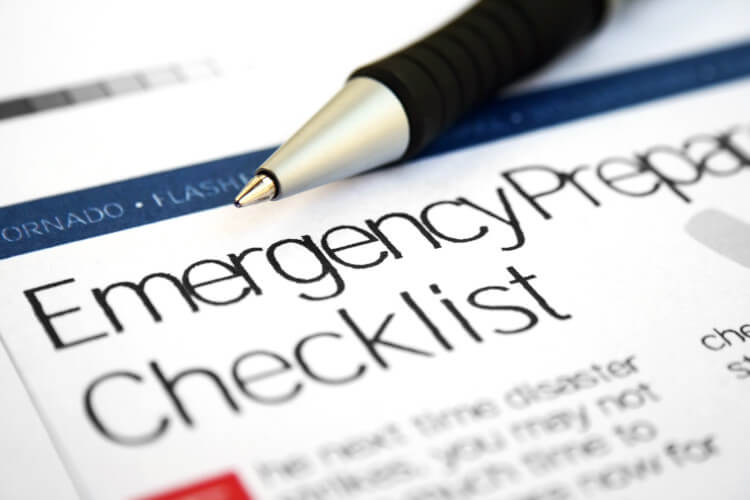
Would you have everything you need readily available should it become necessary to shelter in place or perhaps even evacuate on short notice? You’re better off being proactive and creating your own home emergency preparedness plan than being caught without one should you need it.
Shelter in place supplies
Imagine a scenario wherein a flood has blocked escape routes and, although you are on high ground at home, you are stuck there until the waters recede. As is common in a flood scenario, public water supplies can become contaminated. Electrical power disruptions are not unusual. It is not safe to go out for supplies.
Your shelter in place kit should include at least a one-week supply of non-perishable food for your family. Along with dried food, canned food is an option – unless you lose power and only have an electric can opener. Have a manual one on standby.
Your ability to heat canned food or boil dried food could be impacted, so having a propane, wood, or charcoal grill, starter fluid, and fuel is a good idea. If needed, extra baby food and formula should be kept on hand as well.
Make sure you have at least one gallon of emergency drinking water per day per person. Having at least a week’s supply is recommended. Just in case you end up with no water pressure, keep a few extra gallons on standby to use for flushing toilets, washing hands, and general cleaning.
You can save water and work by also having a supply of disposable plates, bowls, and utensils.
If you have a large freezer, freezing a few gallon jugs of water and keeping them there may allow you to keep perishable food supplies fresh for a while should an extended power outage occur.
If need be, your shelter at home supplies could be taken with you should there be an evacuation. You never know what you might need and, if you have the space, the supplies may come in handy.
First Aid Kits for Any Scenario
Whether you are sheltering in place or evacuating, have a first aid kit on hand. Kits should, at a minimum, include tourniquets to stop bleeding, adhesive bandages for small wounds, gauze, elastic bandages, gloves, a thermometer, pain relievers, antibiotic cream, and topical itch medication.
Medications have expiration dates, so check your kit periodically to ensure those dates have not passed.
Put Together a Bugout Bag
There are some things you simply cannot do until it is time to evacuate, like fill your car’s fuel tank or pack your prescription drugs.
But there are supplies you can pack in a bugout bag now and have on hand just in case. This is where you will pack the bulk of the supplies you may need should there be an evacuation, thus saving critical time in an emergency situation.
Put some personal hygiene items in your bugout bag, like toilet paper, hand sanitizer and wipes. Pack some insect repellent and sunscreen along with oral care items like toothpaste, mouthwash, and extra toothbrushes.
You’ll get emergency updates on a portable radio, so include a radio and batteries. There are also radios available that can be charged using a hand crank. Make sure you pack flashlights and their batteries as well.
Other tools you may need include chargers for phones, a multi-tool, a pocket knife, a saw or hatchet, protective eye wear, cleaning supplies, work gloves, trash bags, a tarp, and perhaps even a tent.
If you have extra blankets, pillows, towels, practical clothes, and rain gear that you can leave in your bugout bag (or bags, by this point), you may want to include those as well. And of course, don’t forget to pack the most versatile tool of all – duct tape.
In addition to putting together your bugout bag(s), keep a basic toolkit in your vehicle and periodically check your tires, including the spare, for proper inflation. Also check the fluid levels regularly and maintain extra supplies of brake fluid, oil, and coolant on board.
Critical Documentation and Information
Should you need to evacuate, and if you can safely do so, there are documents you should gather up and take with you. They include birth certificates, identification cards, Social Security cards, credit cards, insurance policies, home ownership or lease documentation, and vehicle titles.
Time permitting, you may also wish to gather up items such as family photos and albums.
If you have a laptop, take it with you. If you cannot bring your computer and if you’re set up to do so, start a complete backup of your data before you leave, preferably to a cloud storage site.
Maintaining an updated home inventory is also important. A good way to create and maintain an inventory is to simply walk through your home using your phone to make a video.
Go through each room and describe the items as you record. Include information about the value of the items, if known. Do this periodically to ensure that your video inventory stays up to date. If you have cloud storage or backup capabilities for your phone’s data, make sure you back up the video just in case.
This inventory may turn out to be very useful should you need to file an insurance claim.
Supplies to Help You Get Where You’re Going
When preparing to evacuate, remember to fill your vehicle’s fuel tank, get some cash, pack your prescription drugs, and plan your escape route. Lines at the gas pumps get long in a short amount of time when disasters occur, so gas up as soon as possible.
If power fails, having cash on hand could make things a lot easier, so head to the ATM after gassing up. Listen to local emergency broadcasts for information about evacuation routes and hazards.
Once you have decided on your route and get underway, contact someone, perhaps a family member in another geographical area not affected by the event, and let them know where you are going and when you expect to arrive. Tell them you’ll contact them when you get there, if you are delayed, or if your plans change.
Doing this will give them the information they may need in order to summon help should you fail to check in. If you have trouble making a call on your cell phone, understand that voice calls and emails require more data to be transferred than do text messages.
If cell towers are damaged or systems are overloaded, text messages may get through when calls and emails will not.
You’re Ready to Go
Whether you live in a hurricane zone, earthquake central, tornado alley, a flood plane, near a chemical plant, or in the middle of nowhere where it seems nothing bad ever happens, being prepared for a catastrophic event could end up making the difference between protecting your family and yourself or becoming a statistic.
Whatever your situation, taking from this article what is applicable to you and your family and creating your own custom emergency plan doesn’t require a lot of time or effort, and could pay big dividends later.
